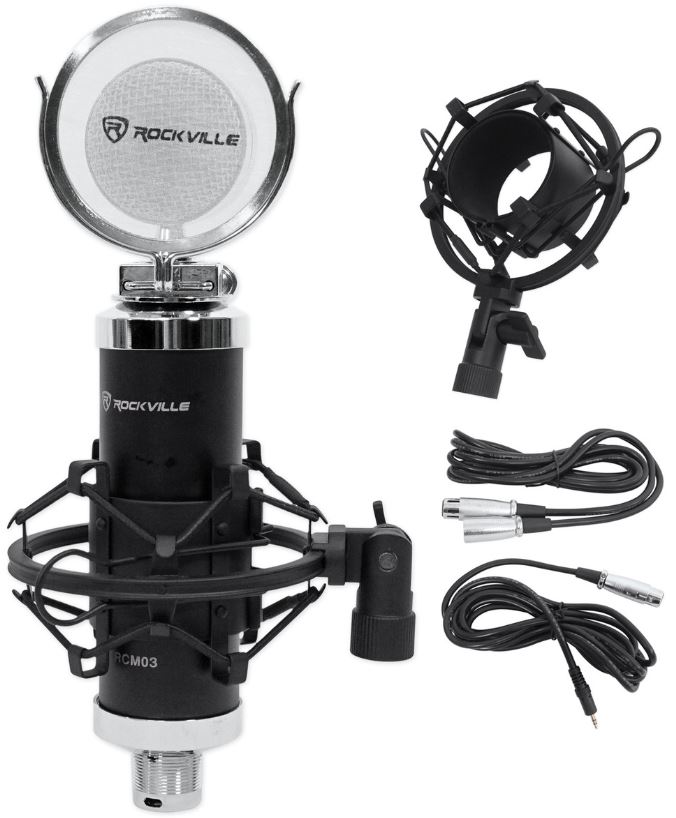
Rockville Studio Recording Condenser Microphone
About Rockville
The brand Rockville Audio is known for its audio gear, which includes speakers, amplifiers, subwoofers, and other items linked to sound. They are renowned for providing a variety of goods aimed at both professional and consumer markets.
Introducing, the Rockville RCM SR, our newest high-quality, professional studio/recording condenser microphone! With its large diaphragm it provides a smooth, natural sound and low noise, it also delivers great bass, mids, and highs on all of your recordings. This microphone is very sensitive to incoming sounds to give you the best possible sound! In addition, it includes a 25mm cartridge that allows for a bigger pickup area to pick up incoming sound. The cartridge is the most important aspect that determines the sound quality, and the RCM SR has one of the best-quality cartridges available for any microphone in its class.
The RCM SR can be used in multiple ways. You can connect this to the phantom power of your mixer or you can connect it directly to your computer sound card. We include a cable to connect it to your mixer as well as a cable to connect the mic to your computer!
This microphone has two capacitors (22µ50V and 47µ16V). We used Samsung capacitors from Korea, which are the highest-quality capacitors on the market. These are important to help stabilize the voltage so that your recordings are consistent throughout, even if there are sudden changes in the volume or frequency ranges.
The PCB (circuit board) uses surface-mounted components which is the same method the expensive brands use. We use only top components that undergo extreme testing by our own audio engineers.
The last thing you should know is that our product is very sturdy. When you are recording, you do not want even the slightest noise coming from your mic. Microphones consist of a casing inside of which there is a cartridge. You definitely do not want that cartridge moving around. We made sure to adjust our mechanism so as to ensure the cartridge was firmly in place and not creating any unwanted noises.
It is important to position the microphone directly in line (on the axis) with the person speaking/ singing or the instrument (or other sound source) to achieve the best frequency response. For use in speaking/singing applications, the ideal placement for the microphone is directly in front of the person speaking/singing. The same placement is optimal when micing an instrument such as an acoustic guitar, drums, or piano. Experiment with different mic placements to find the best sound for your particular setup.
FEATURES and SPECIFICATIONS
- Best Applications: Home studio, recording studio, broadcasting, podcasts, live performances, and much more!
- 25mm Large cartridge – allows for a bigger pickup area
- Two large capacitors: 22µ50V and 47µ16V
- Large diaphragm – provides smooth natural sound, low noise, and great bass, mids, & highs
- High SPL handling and wide dynamic range
- The cardioid polar pattern reduces the pickup of sounds from the sides and rear, reducing unwanted noise
- Element: Fixed-charge back plate, permanently polarized condenser
- The microphone head is made of high-quality steel featuring one-piece head design
- The microphone body is made of special aluminum metal material -which prevents noise from shock and vibrations
- Frequency response: 20Hz – 20 kHz
- Open circuit sensitivity: -30dB ±2dB (0dB = 1 V/Pa @ 1 kHz)
- Impedance: 100 Ohms
- Equivalent noise level:= 23dB A (IEC581-5)
- Maximum input sound level: 142dB SPL (THO= 1.0% @ 1 kHz)
- Electrical current: >= 500 Ua
- Noise: 20dB SPL
- Dynamic range (typical): 124 dB, 1 kHz @ Max SPL
- Signal-to-Noise ratio: 7 4 dB, 1 kHz @ 1 Pa
- PCB layout: Surface mount
- Fixed crossover filter cutoff frequency: 50Hz – 16kHz
- Power requirements: 48V DC Phantom power or computer sound card
- Output connector: 3-Pin XLR
- Microphone weight: 0.67 Lbs (305 grams)
- Microphone height: 6.18″ (157mm)
- Microphone diameter: 1.89″ (48mm)
INCLUDED
- RCM SR Condenser Microphone
- 100% Copper 10 foot 3.5mm jack to XLR cable to connect the mic to your computer
- 100% 10-foot XLR to XLR cable to connect to any mixer with phantom power
- Metal shock mount
- Large Wind-Screen/Pop Filter
- Owners manual
- Warranty card
FAQS About Rockville Studio Recording Condenser Microphone
How far away from the recording should a condenser mic be?
7 to 12 inches
What else does a condenser microphone require?
Phantom strength.
How durable are condenser microphones?
20-30 years
How much electricity is used by a condenser microphone?
11.5-22. volts
Do condenser microphones lessen noise?
It is more sensitive to use a condenser microphone. In comparison to a dynamic microphone, it turns noise into electrical at a higher level. It is more sensitive to every noise, including the sound of your voice and the air conditioner.
What is a condenser microphone’s optimum quality?
They are excellent for clearly and precisely capturing delicate noises.
A condenser microphone can be used to record what instruments?
Horns, acoustic guitar, upright bass, and stringed instruments
Why do condenser microphones require power?
They transform air vibrations into audio signals using electronic circuitry.
Are condenser microphones delicate?
Dynamic microphones are less sensitive than condenser microphones.
Do condenser microphones produce self noise?
Very low self-noise figures are often only obtained on contemporary big diaphragm condenser microphones.
How far does a condenser microphone have a range?
4–8 inches, or 10–20 cm.
How should a condenser mic be used when performing live?
Step back from the microphone by six inches.
Do condenser microphones require batteries?
While a few condenser microphones can be powered in different ways (such as by a battery),
For more manuals by Rockville, Visit Manualsdock
[embeddoc url=”https://manualsdock.com/wp-content/uploads/2023/10/Rockville-Studio-Recording-Condenser-Microphone-Manual.pdf” download=”all”]


